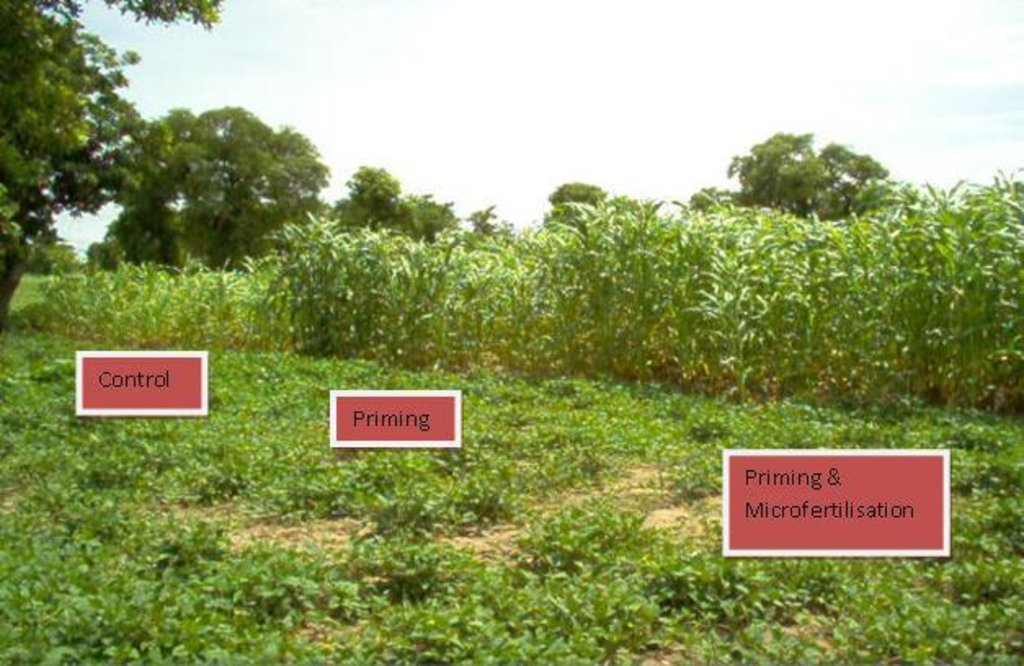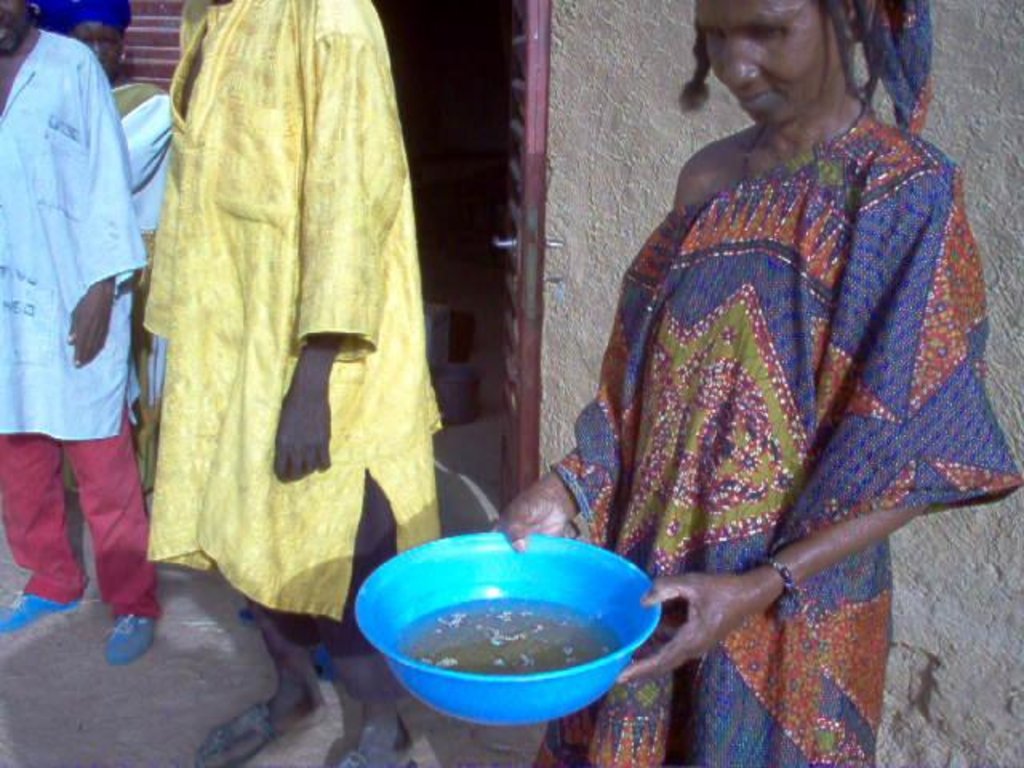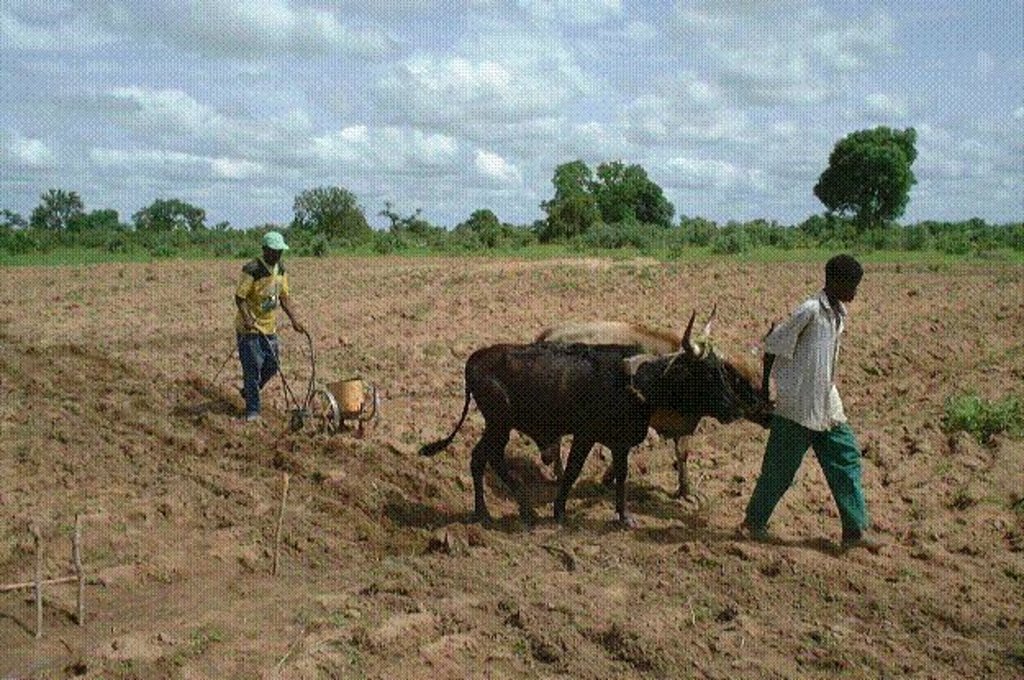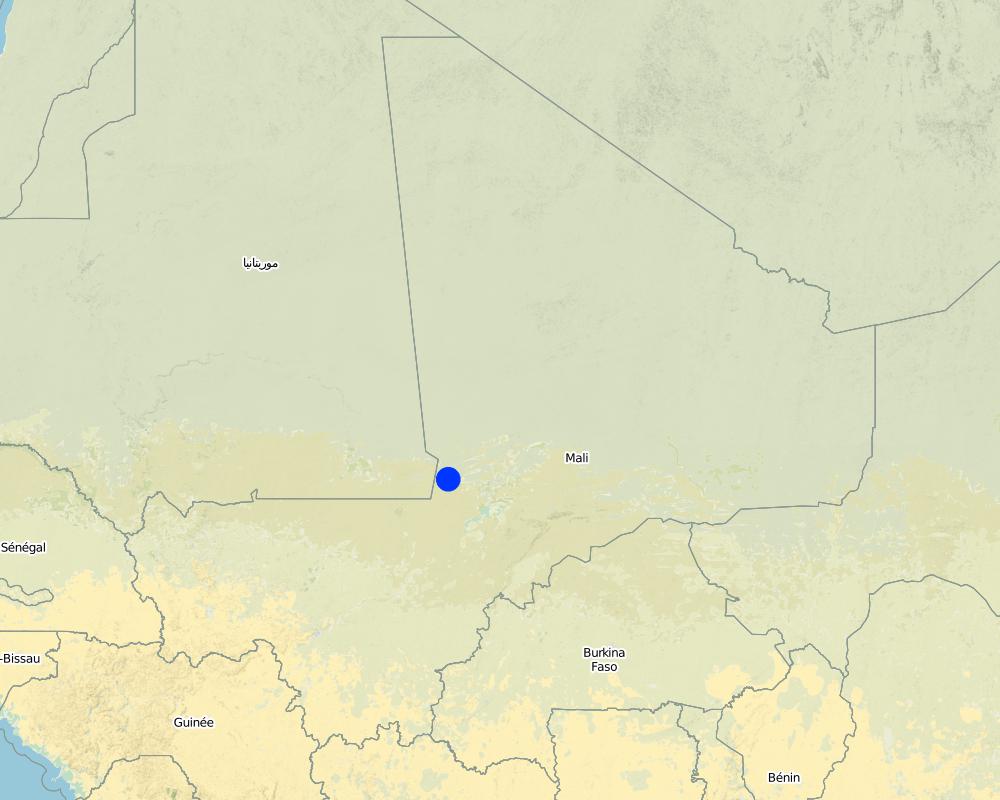Seed Priming and Microfertilization [Mali]
- Creation:
- Update:
- Compiler: Unknown User
- Editor: –
- Reviewers: Fabian Ottiger, Alexandra Gavilano
technologies_1328 - Mali
View sections
Expand all Collapse all1. General information
1.2 Contact details of resource persons and institutions involved in the assessment and documentation of the Technology
Key resource person(s)
SLM specialist:
Aune Jens
Norwegian University of Life Sciences
Norway
Name of project which facilitated the documentation/ evaluation of the Technology (if relevant)
Book project: SLM in Practice - Guidelines and Best Practices for Sub-Saharan Africa (SLM in Practice)Name of the institution(s) which facilitated the documentation/ evaluation of the Technology (if relevant)
Norwegian University of Life Sciences (Norwegian University of Life Sciences) - Norway1.3 Conditions regarding the use of data documented through WOCAT
The compiler and key resource person(s) accept the conditions regarding the use of data documented through WOCAT:
Ja
2. Description of the SLM Technology
2.1 Short description of the Technology
Definition of the Technology:
Seed priming and microfertilization are two agronomic measures to increase soil fertility and increase crop harvests in semi-arid drylands.
2.2 Detailed description of the Technology
Description:
Seed priming consists of soaking seeds for 8 hours prior to sowing and microfertilization is the application of small amounts of mineral fertilizer to the planting hole.
Purpose of the Technology: Seed priming and microfertilization have been found to be effective in increasing pearl millet and sorghum yields under dryland cropping systems. It is also applicable for cowpeas, groundnuts and sesame. Priming will increase the water use efficiency because the seed can start to germinate immediately after sowing. Results from Mali (Koro and Segou) show that yields can be increased by 50 % if microfertilization is combined with seed priming. Other benefits are reduced labour constraints (thanks to simultaneous application) and risk reduction. Seed priming and microfertilization can be practiced independently from each other; however, the combination reduces the risk of crop failure and shows best results in terms of yield increase. Microfertilization has also been mechanised in Mali.
Establishment / maintenance activities and inputs: Seed priming should be carried out after a rain shower sufficient for sowing (15-20 mm) at the beginning of the rainy season. After soaking, the seeds should be air dried for 1 hour prior to sowing (to reduce the stickiness of the seeds and to reduce risk of burning by fertilizer). Fertilizer (NPK 16-16-16; or DAP) is applied at a micro-dose of 0.3 g per planting station, equivalent to 3-8 kg fertilizer/ha, dependent on plant population density. The air-dried seeds and the fertilizer can be applied simultaneously by first mixing the seeds and the fertilizer and thereafter taking a pinch of the mixture between the thumb and the forefinger.
Natural / human environment: The Mopti region is located in the semi-arid Sahel with an average annual rainfall of 400-800 mm during one 3.5 month rainy season. A participatory rural appraisal (PRA) study undertaken in 1999 identified soil fertility as one of the farmers’ most serious constraints.
2.3 Photos of the Technology
2.5 Country/ region/ locations where the Technology has been applied and which are covered by this assessment
Country:
Mali
Region/ State/ Province:
Mopti Region
Further specification of location:
Koro
Map
×2.6 Date of implementation
If precise year is not known, indicate approximate date:
- less than 10 years ago (recently)
2.7 Introduction of the Technology
Specify how the Technology was introduced:
- during experiments/ research
- through projects/ external interventions
3. Classification of the SLM Technology
3.1 Main purpose(s) of the Technology
- improve production
- create beneficial economic impact
3.2 Current land use type(s) where the Technology is applied

Cropland
- Annual cropping
Comments:
Major land use problems (land users’ perception): soil fertility decline, insufficiency or unavailability of arable lands, population growth and its impact on reducing land availability, frequency and length of fallow periods, insufficient flooding of the plains, increasing soil erosion
3.4 Water supply
Water supply for the land on which the Technology is applied:
- rainfed
3.5 SLM group to which the Technology belongs
- integrated soil fertility management
- Seed priming
3.6 SLM measures comprising the Technology

agronomic measures
- A2: Organic matter/ soil fertility
Comments:
Main measures: agronomic measures
3.7 Main types of land degradation addressed by the Technology

chemical soil deterioration
- Cn: fertility decline and reduced organic matter content (not caused by erosion)
Comments:
Main type of degradation addressed: Cn: fertility decline and reduced organic matter content
Main causes of degradation: soil management (Use of organic and inorganic fertilisers lower than recommended, reduction in fallow period), crop management (annual, perennial, tree/shrub) (removal of crop residues), other human induced causes (specify) (clearing and cultivation of marginal lands), other natural causes (avalanches, volcanic eruptions, mud flows, highly susceptible natural resources, extreme topography, etc.) specify (natural low soil fertility and fragile soils), population pressure
3.8 Prevention, reduction, or restoration of land degradation
Specify the goal of the Technology with regard to land degradation:
- reduce land degradation
4. Technical specifications, implementation activities, inputs, and costs
4.1 Technical drawing of the Technology
Technical specifications (related to technical drawing):
Technical knowledge required for field staff / advisors: low
Technical knowledge required for land users: low
Main technical functions: increase in nutrient availability (supply, recycling,…)
4.2 General information regarding the calculation of inputs and costs
other/ national currency (specify):
CFA
Indicate average wage cost of hired labour per day:
2.00
4.5 Maintenance/ recurrent activities
| Activity | Timing/ frequency | |
|---|---|---|
| 1. | Soak seeds for 8 hours prior to sowing | onset of rainy season, late June |
| 2. | Mix seeds and NPK fertilizer (16-16-16) or DAP at a ratio of 1:1 | before sowing |
| 3. | Sow seeds and fertilizer simultaneously and cover with soil | None |
Comments:
Seed priming and microfertilization are agronomic measures which are carried out repeatedly each cropping season. All activities are listed under maintenance / recurrent activities (below). There is no establishment phase (as defined by WOCAT). Seed priming can be started after sufficient rain for sowing has been received. If the method fails, it can be repeated again. Option: If farmers have the resources to buy higher amount of fertilizer and if the season is promising, they can apply 2 g fertilizer per pocket at first weeding (20 days after sowing). This results in higher yields but also requires an additional operation for the farmer, tripling the labour inputs for fertilizer application. If this practice is adopted, it is not necessary to apply 0.3 g fertilizer at sowing. All activities are carried out by manual labour; microfertilisation has partly been mechanised, using an ox-drawn implement.
4.6 Costs and inputs needed for maintenance/ recurrent activities (per year)
| Specify input | Unit | Quantity | Costs per Unit | Total costs per input | % of costs borne by land users | |
|---|---|---|---|---|---|---|
| Labour | Labour | ha | 1.0 | 1.0 | 1.0 | |
| Fertilizers and biocides | Fertilizer | ha | 1.0 | 2.0 | 2.0 | |
| Total costs for maintenance of the Technology | 3.0 | |||||
| Total costs for maintenance of the Technology in USD | 3.0 | |||||
Comments:
Machinery/ tools: weeding tool
Sowing can alternatively be mechanised, which will cause establishment costs (purchase of the sowing machine)
4.7 Most important factors affecting the costs
Describe the most determinate factors affecting the costs:
Fertilizers
5. Natural and human environment
5.1 Climate
Annual rainfall
- < 250 mm
- 251-500 mm
- 501-750 mm
- 751-1,000 mm
- 1,001-1,500 mm
- 1,501-2,000 mm
- 2,001-3,000 mm
- 3,001-4,000 mm
- > 4,000 mm
Specifications/ comments on rainfall:
500-750 mm (ranked 1, length of dry period: 8 months) as well as 250-500 mm and 750-1000 mm (ranked 2)
Agro-climatic zone
- semi-arid
Thermal climate class: tropics
5.2 Topography
Slopes on average:
- flat (0-2%)
- gentle (3-5%)
- moderate (6-10%)
- rolling (11-15%)
- hilly (16-30%)
- steep (31-60%)
- very steep (>60%)
Landforms:
- plateau/plains
- ridges
- mountain slopes
- hill slopes
- footslopes
- valley floors
Altitudinal zone:
- 0-100 m a.s.l.
- 101-500 m a.s.l.
- 501-1,000 m a.s.l.
- 1,001-1,500 m a.s.l.
- 1,501-2,000 m a.s.l.
- 2,001-2,500 m a.s.l.
- 2,501-3,000 m a.s.l.
- 3,001-4,000 m a.s.l.
- > 4,000 m a.s.l.
Comments and further specifications on topography:
Altitudinal zone: 1001-500 m a.s.l. (260m)
5.3 Soils
Soil depth on average:
- very shallow (0-20 cm)
- shallow (21-50 cm)
- moderately deep (51-80 cm)
- deep (81-120 cm)
- very deep (> 120 cm)
Topsoil organic matter:
- low (<1%)
If available, attach full soil description or specify the available information, e.g. soil type, soil PH/ acidity, Cation Exchange Capacity, nitrogen, salinity etc.
Soil fertility: Low
5.6 Characteristics of land users applying the Technology
Market orientation of production system:
- mixed (subsistence/ commercial)
Relative level of wealth:
- average
- rich
Individuals or groups:
- individual/ household
Level of mechanization:
- manual work
- animal traction
Gender:
- women
- men
Indicate other relevant characteristics of the land users:
Land users applying the Technology are mainly common / average land users
5.7 Average area of land used by land users applying the Technology
- < 0.5 ha
- 0.5-1 ha
- 1-2 ha
- 2-5 ha
- 5-15 ha
- 15-50 ha
- 50-100 ha
- 100-500 ha
- 500-1,000 ha
- 1,000-10,000 ha
- > 10,000 ha
Is this considered small-, medium- or large-scale (referring to local context)?
- small-scale
Comments:
2-20 ha
5.8 Land ownership, land use rights, and water use rights
Land ownership:
- communal/ village
Land use rights:
- communal (organized)
- individual
6. Impacts and concluding statements
6.1 On-site impacts the Technology has shown
Socio-economic impacts
Production
crop production
Comments/ specify:
combined effect of seed priming and microfertilisation 50%, seed priming alone 25%
fodder production
Comments/ specify:
increased production of straw
risk of production failure
Comments/ specify:
Risk minimisation: decreased risk of crop failure; and low financial risk in the case of crop failure; seed priming reduces the risk of fertilizer application
Income and costs
expenses on agricultural inputs
Comments/ specify:
Decreased financial resources needed for purchasing fertilizer, makes the technology feasible for poor small-scale farmers
Other socio-economic impacts
Land productivity
Comments/ specify:
clearance of new land is avoided
Earlier harvest (food security)
Ecological impacts
Biodiversity: vegetation, animals
pest/ disease control
Comments/ specify:
Increased resistance to Striga (pest)
Climate and disaster risk reduction
drought impacts
Comments/ specify:
Reduced susceptibility to beginning-of-season droughts; less burning effect if drought after sowing
6.3 Exposure and sensitivity of the Technology to gradual climate change and climate-related extremes/ disasters (as perceived by land users)
Gradual climate change
Gradual climate change
| Season | increase or decrease | How does the Technology cope with it? | |
|---|---|---|---|
| annual temperature | increase | not known |
Climate-related extremes (disasters)
Meteorological disasters
| How does the Technology cope with it? | |
|---|---|
| local rainstorm | not known |
| local windstorm | not known |
Climatological disasters
| How does the Technology cope with it? | |
|---|---|
| drought | well |
Hydrological disasters
| How does the Technology cope with it? | |
|---|---|
| general (river) flood | not known |
Other climate-related consequences
Other climate-related consequences
| How does the Technology cope with it? | |
|---|---|
| reduced growing period | not known |
6.4 Cost-benefit analysis
How do the benefits compare with the maintenance/ recurrent costs (from land users' perspective)?
Short-term returns:
very positive
Long-term returns:
very positive
Comments:
The technology has a benefit-cost ratio of 10 (increased production value is 10 times higher than the costs for additional fertilizer). Compared to the 6 g microfertilisation method (using Coke caps) cost-benefits ratio of 0.3 g treatment is 8-20 times hi
6.5 Adoption of the Technology
Of all those who have adopted the Technology, how many did so spontaneously, i.e. without receiving any material incentives/ payments?
- 51-90%
Comments:
50% of land user families have adopted the Technology without any external material support
Comments on spontaneous adoption: Field officers from NGO’s report that in some villages in the “Dogon area” in the Mopti region more than 50 % of the farmers are using the technologies on their own initiative.
There is a strong trend towards spontaneous adoption of the Technology
Comments on adoption trend: Microfertilization has become a very popular technology in some area in Mali.
6.7 Strengths/ advantages/ opportunities of the Technology
| Strengths/ advantages/ opportunities in the compiler’s or other key resource person’s view |
|---|
| Decreased financial resources needed for purchasing fertilizer, makes the technology feasible for poor small-scale farmers |
| No additional labour inputs (the technology does not significantly increase sowing time due to simultaneous application of seeds and fertilizer) |
| Adaptability to different land use systems: micro-fertilization can also be mechanised |
6.8 Weaknesses/ disadvantages/ risks of the Technology and ways of overcoming them
| Weaknesses/ disadvantages/ risks in the compiler’s or other key resource person’s view | How can they be overcome? |
|---|---|
| Dependence partly on availability of mineral fertilizer | the technology should be combined with complementary methods for maintenance of soil fertility, such as increased recycling of crop residues as mulch and manure application |
7. References and links
7.2 References to available publications
Title, author, year, ISBN:
Aune JB, Doumbia M, Berthe A (2007): Microfertilizing sorghum and pearl millet in Mali - Agronomic, economic and social feasibility in Outlook on AGRICULTURE Vol 36, No 3, 2007, pp 199–203;
Title, author, year, ISBN:
Aune JB, Doumbia M, Berthe A (2005): Integrated Plant Nutrient Management Report 1998-2004; Drylands Coordination Group Report 36, Norway;
Title, author, year, ISBN:
Aune JB, Bationo A (2008): Agricultural intensification in the Sahel. Agricultural Systems 98: 119-125
Title, author, year, ISBN:
Habima, D. 2008. Drylands ecofarming: An analysis of ecological farming prototypes in two Sahelian zones: Koro and Bankass. M.Sc Thesis, UMN, Ås, Norway
Links and modules
Expand all Collapse allLinks
No links
Modules
No modules







